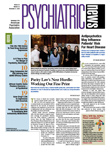The Food and Drug Administration (FDA) has cleared the first transcranial magnetic stimulation (TMS) device for treatment of medication-resistant depression, the device manufacturer Neuronetics Inc. announced last month.
The device, known as NeuroStar TMS Therapy system, is indicated as a daily monotherapy for adults with major depressive disorder who have failed to respond to at least one course of antidepressant treatment with an adequate dosage and duration.
The device works by applying repeated, high-frequency magnetic pulses at a specific location outside the cranium to provoke electrical currents inside the patient's brain, thus activating the neurons in the prefrontal cortex.
The procedure, which is noninvasive and painless, is conducted in the outpatient setting. Unlike electroconvulsive therapy (ECT), patients need no anesthesia or sedation. The patient remains awake and alert during a 40-minute session of stimulation, in which the device delivers 3,000 pulses per session.
In a randomized, sham-controlled, double-blind clinical trial of the TMS device conducted from January 2004 to August 2005, more than 300 patients with major depression who had failed previous pharmacotherapy were randomized to receive either active or sham stimulation every day for six weeks. Patients in the study had previously failed a median of four courses of antidepressant therapy.
The TMS treatment was shown to be significantly more effective than sham stimulation in reducing depressive symptoms at weeks 4 and 6 as measured by the Montgomery-Asberg Depression Rating and Hamilton Depression Rating scales. Clinical trial results were published in the December 1, 2007, Biological Psychiatry by John O'Reardon, M.D., and colleagues.
Some of the patients in the randomized clinical trial continued with active, open-label treatment for up to 24 weeks. Relatively few adverse effects were reported. The most common treatment-related adverse events were headaches and scalp pain or discomfort, which were transient and mild to moderate in severity. There were no deaths or seizures, according to a summary of the safety data from these trials published in the February Journal of Clinical Psychiatry by Philip Janicak, M.D., and colleagues. No memory loss or cognitive changes were seen in patients in the trials. Less than 5 percent of the study sample discontinued treatment because of adverse events.
One serious adverse event reported in the trials was left-sided facial numbness in one patient, which was related to irritation of the trigeminal nerve. The event resolved after the treatment was discontinued. First-degree burns in two patients and severe pain at the treatment site in one patient, all due to device malfunction, occurred in the first trial.
“Those early events in the clinical trial were caused by a technical issue with a prototype of the device,” Mark Demitrack, M.D., the medical director of Neuronetics, told Psychiatric News. The problem was remedied in the redesigned commercial version of the device and did not occur again in the clinical trials.
The device stimulates a specific area of the brain—the left dorsolateral prefrontal cortex. The stimulation over time, however, is likely to lead to beneficial changes in other regions involved in depression, Sarah Lisanby, M.D., chief of the Columbia Brain Stimulation and Therapeutic Modulation Division, told Psychiatric News. Lisanby, a professor of clinical psychiatry at Columbia University and the New York State Psychiatric Institute, was one of the investigators involved in the Neuronetics trials of the device. She is also the chair of APA's Task Force to Revise the Practice of Electroconvulsive Therapy.
“One of the goals of studying TMS has been to see if it can offer help for patients when medications fail and to find out where it may fit into the overall treatment for depression,” she said, noting that TMS is not invasive and has fewer cognitive side effects than ECT and thus may present a second option after pharmacotherapy, but before initiating ECT.
In January 2007, an advisory panel told the FDA that the device is safe, but that its efficacy may not be “substantially equivalent” to ECT. Thus it was not approved for a premarket 510(K) notification sought by the company. 501(K) is an accelerated market-approval process in which the applicant needs only to prove that a device is “substantially equivalent” to another marketed device in safety and efficacy. Thus the FDA had requested additional analyses of the clinical trial data and issued the clearance nearly two years later.
TMS treatment is “vastly different from ECT,” said Demitrack. He emphasized that the appropriate indication for the device is for use in patients who have failed a course of drug therapy with an adequate dose and duration, which is not the same as the first antidepressant drug tried unsuccessfully by a patient. Because of tolerability problems, many patients have to try several antidepressant drugs for months before completing one course of pharmacotherapy at minimum effective dose and duration, he emphasized.
In a study published August 13 in Neuropsychopharmacology online, Lisanby and colleagues analyzed the clinical trial data and found that patients who had failed one adequate course of antidepressant treatment responded significantly better than those who had failed multiple courses of full-dose, f ull-duration antidepressant treatment.
The TMS device will be available at a limited number of treatment centers at first, but its availablity will be expanded in the next year, according to the company's announcement.
An abstract of “Efficacy and Safety of Transcranial Magnetic Stimulation in the Acute Treatment of Major Depression: A Multisite Randomized Controlled Trial” is posted at<www.journals.elsevierhealth.com/periodicals/bps/article/S0006-3223(07)00146-1/abstract>.
An abstract of “Transcranial Magnetic Stimulation in the Treatment of Major Depressive Disorder: A Comprehensive Summary of Safety Experience From Acute Exposure, Extended Exposure, and During Reintroduction Treatment” is posted at<www.psychiatrist.com/abstracts/abstracts.asp?abstract=200802/020807.htm>.
An abstract of “Daily Left Prefrontal Repetitive Transcranial Magnetic Stimulation in the Acute Treatment of Major Depression: Clinical Predictors of Outcome in a Multisite, Randomized Controlled Clinical Trial” is posted at<www.nature.com/npp/journal/vaop/ncurrent/abs/npp2008118a.html>.▪
